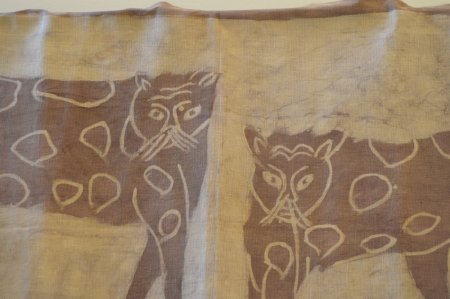Title:
Two Leopards Batik
Object Name:
Batik, Textile, Two Leopards
Other Name:
Wax Resist
Place of Origin:
Unknown
Provenance:
Aboriginal Indigenous Art.
L = 28—1/2"
W = 42—1/2"
Possibly of Nigerian origin: In Africa, where batik was originally imported by Dutch merchants from Indonesia (then the Netherlands East Indies), paste made from starch or mud is used as a resist instead of wax. The most developed resist—dyeing skills are to be found in Nigeria where the Yoruba make adire cloths. Two methods of resist are used adire eleso which involves tied and stitched and adire eleko that uses starch paste. The paste is most often made from cassava starch, rice, and other ingredients boiled together to produce a smooth thick paste. The Yoruba of West Africa use cassava paste as a resist while the Soninke and Wolof people in Senegal uses rice paste. The Bamana people of Mali use mud as a resist
L = 28—1/2"
W = 42—1/2"
Possibly of Nigerian origin: In Africa, where batik was originally imported by Dutch merchants from Indonesia (then the Netherlands East Indies), paste made from starch or mud is used as a resist instead of wax. The most developed resist—dyeing skills are to be found in Nigeria where the Yoruba make adire cloths. Two methods of resist are used adire eleso which involves tied and stitched and adire eleko that uses starch paste. The paste is most often made from cassava starch, rice, and other ingredients boiled together to produce a smooth thick paste. The Yoruba of West Africa use cassava paste as a resist while the Soninke and Wolof people in Senegal uses rice paste. The Bamana people of Mali use mud as a resist
Description:
Woven textile, with the image of two leopards. Dark brown and tan in color.
Collection:
Marianne Keown Collection
Material:
Cotton
Used:
Domestic Use
Technique:
Weaving / Wax Resist
Owned:
Art Department, Missouri Southern State University
Accession#:
2015.3.9

